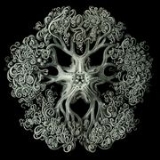
Gorgonocephalidae
Encyclopedia
Gorgonocephalidae are a family of Basket star
s.They have characteristic many-branched arms.
Gorgonocephalidae are the largest ophiuroid
s (Gorgonocephalus stimpsoni can measure up to 70 cm in arm length with a disk diameter of 14 cm).
Fossil record of Gorgonocephalidae dates back to Miocene
.
Basket star
Basket stars are a group of brittle stars. They are treated as a suborder Euryalina or order Euryalida. Many of them have characteristic many-branched arms. They generally live in deep sea habitats.The life span in the wild is up to 35 years. They weigh around 11 lbs, or 5 kg...
s.They have characteristic many-branched arms.
Gorgonocephalidae are the largest ophiuroid
Brittle star
Brittle stars or ophiuroids are echinoderms in the class Ophiuroidea closely related to starfish. They crawl across the seafloor using their flexible arms for locomotion. The ophiuroids generally have five long slender, whip-like arms which may reach up to in length on the largest specimens...
s (Gorgonocephalus stimpsoni can measure up to 70 cm in arm length with a disk diameter of 14 cm).
Systematics and phylogeny
Gorgonocephalidae are divided into the following genera:
|
Astrophyton The giant basket star is an echinoderm found throughout the Caribbean Sea and the Gulf of Mexico.During the day, it curls up into a tight ball shape to protect itself from predators... |
Fossil record of Gorgonocephalidae dates back to Miocene
Miocene
The Miocene is a geological epoch of the Neogene Period and extends from about . The Miocene was named by Sir Charles Lyell. Its name comes from the Greek words and and means "less recent" because it has 18% fewer modern sea invertebrates than the Pliocene. The Miocene follows the Oligocene...
.

